Carbide Lamps
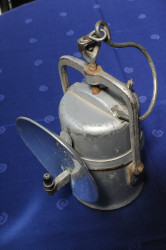
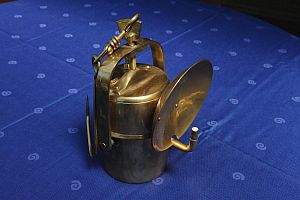
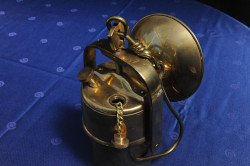
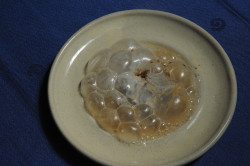
Carbide lamps have been used since the end of the 19th century. They have an open flame and a metal reflector, they spread a slightly yellowish, even and bright light. In addition, the fuel is sufficient for several hours, with conventional design of the lamp 8 to 10 hours can easily be achieved. So they are superior to other lamps with open flame like candles, petroleum lamps etc., but have the disadvantages of all lamps with an open flame: the flame can be extinguished by wind, there is a risk of burns and burnt equipment, and in the presence of combustible gases can cause explosions. In coal mining, for example, they can only be used in the form of safety lamps.
The fuel in carbide lamps is acetylene gas which is produced inside the lamp from calcium carbide and water by exothermic reaction. Calcium carbide (or carbide for short), is a lime-like white stone made from burnt lime and coke. When water is added an exothermic reaction starts, which produces CaO and a large amount of acetylene gas. CaO slowly turns into limestone with carbon dioxide from the air. Acetylene gas has a very low weight, so it is lighter than air, and burns very hot. It burns nearly as hot as hydrogen, and is thus also used for welding. The central reaction is the following one, which happens immediately when water and carbide get in touch:
CaC2 + H2O => C2H2 + CaO + heat + light
The lamp has an airtight container for the carbide, a water container from which the carbide is brought into contact with water in a controlled way, a burner, i.e. a simple nozzle for the outflowing gas and a reflector which directs the light of the flame in a certain direction.
Acetylene gas burns with a very hot flame, in fact it is the second-hottest flame after hydrogen. Acetylene is much easier to handle than hydrogen because it is less easy to form an explosive oxyhydrogen gas and does not diffuse through the metal of its container like hydrogen. It can also be made from carbide and water in large quantities. For these reasons it was used for a long time as fuel for lamps but also for welding in craft and industry.
Carbide lamps were used in mining, in daily life, as bicycle lamps, carriage lamps, and in speleology. They are no longer used in speleology today, they were first banished from small caves due to their side product of soot, and now they are also replaced by bright LED lamps in large caves. In addition, it is becoming increasingly difficult to buy carbide because it is no longer used industrially and is therefore only produced in small quantities. The heyday of carbide lamps in speleology was in the middle of the 20th century, until about the end of the 1980s. In mining, they were already replaced in the 1950s and 1960s by incandescent electric lamps with lead accumulators. However, those did never become common in speleology for three reasons: they were expensive, the burning time was limited, and they could not be used for cave expeditions lasting several days or in the outback due to a lack of electricity for recharging, whereas replacement carbide was light and handy.
Like all lamps used in mining, carbide lamps are available in two versions, one made of iron or steel and one made of brass. The brass lamps are also called foreman lamps because they were reserved for the foreman. The foreman was responsible for surveying the new tunnels. But steel has ferromagnetic properties and can interfere with the measurement of the direction, if it is measured with a compass. Brass lamps are not magnetic and can not cause this problem, but otherwise have no advantages and are much more expensive. That is why they were only used by foremen.
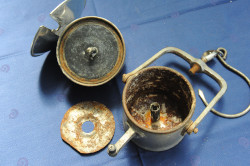
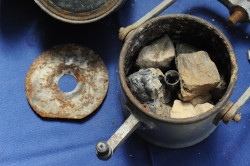
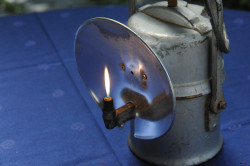
 Search DuckDuckGo for "Carbide Lamp"
Search DuckDuckGo for "Carbide Lamp" Carbide lamp - Wikipedia (visited: 13-MAY-2020)
Carbide lamp - Wikipedia (visited: 13-MAY-2020) Carbide Lamps (visited: 13-MAY-2020)
Carbide Lamps (visited: 13-MAY-2020)
 Index
Index Topics
Topics Hierarchical
Hierarchical Countries
Countries Maps
Maps